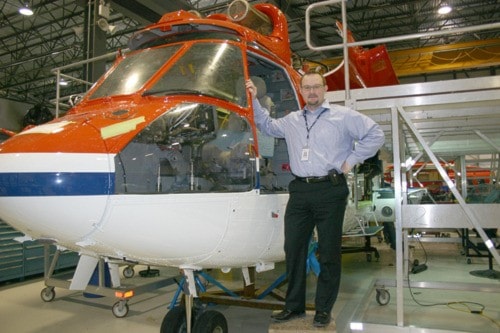It’s pretty straight forward and simple when your company’s delivery truck gets a flat tire or needs an engine tune up to get it back on the road again.
There are plenty of mechanic shops that deal with all kinds of rigs and their needed repairs and maintenance.
But when your business deals with multimillion-dollar aircraft that require specific maintenance cycles not only to keep them in operation but maintain strict safety standards, not any old shop on the high street will do.
In steps South Delta-based Heli-One which opened a massive (234,000-square-foot) overhaul and repair facility in 2008 adjacent to Boundary Bay Airport where customers from around the globe send their helicopters to get scheduled work performed.
Looking out into the large shop floor it’s not uncommon to see aircraft emblazoned in livery from places like Central America and Europe.
In between are good doses of aircraft bearing the red and blue colours of Heli-One’s parent company CHC, because with one of the largest fleets of rotary wing aircraft in the world—primarily tasked with offshore drilling operations—they have to get their own maintenance seen to somewhere.
Then there’s a smattering of matt grey and olive drab machines clearly denoting their military function.
Just about whatever the type of helicopter and its task, Heli-One is prepared to work on in it—from nose to tail.
“We have the capability to tear down a whole aircraft and rebuild it,” said Timothy Blaskovich, director of the engine shop at Heli-One. “Other jobs would be to run some major maintenance cycles. Or incorporate new interior finishes for aircraft.”
It’s a one-stop location that employs upwards of 350 employees who work on aircraft for customers who need them back in the air and working as soon as possible.
Blaskovich said helicopter maintenance can be fairly intensive work.
“Some level of maintenance is done in the field, at 800 hours (of use) typically. But for the more major type of work the aircraft can go into a hangar and have significant work done to them.”
Part of that is the ability to also work on the aircraft’s engines in a designated part of Heli-One’s sprawling building which has a pair of engine run-up test cells where the repaired or overhauled power plants are monitored with special equipment to ensure they are in working order.
Despite Heli-One’s large work load it still represents just a fraction of the need for maintenance, repair and overhaul (MRO) work, said Andrew Huige, spokesperson for the company.
“Even though we are the largest, third-party MRO, we still have only five per cent of the world market,” he said. “There’s tons more to go around. The maintenance side is the area for growth in our business.”
Blaskovich said the Delta facility could bring in more business, but the facility’s size has its limitations.
“It’s an ongoing challenge to marry the forecasts from the sales team to the operations logistics side.”
editor@southdeltaleader.com
